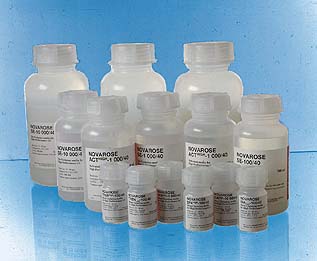| Chelating High Performance Agarose for Immobilised Affinity Chromatography |
| Novarose™ IDA High , Novarose™ IDA Low , Novarose™ TREN High , Novarose™ TREN Low, Novarose™ DPA High and Novarose™ DPA Low |
| The Novarose™series of immobilized affinity chromatography (IMAC) gels are cross-linked agarose beads activated and coupled according to the bromohydrine method [1 ].This method gives rise to a spacer arm of 4 to 16 atoms length between the agarose backbone and the attached chelator. |
|
| Novarose
gels are supplied in aqueous suspensions with ethanol as a preservative and are
immediately ready for use after washing. The ligand density has been shown to have an
great impact on the separation (3,4). In some cases, a high capacity gel is needed, while
in other cases a low capacity gel may solve the problem. Novarose IMAC gels
are available in three pore sizes and two degrees of substitution,low and high, to allow
maximum flexibility when selecting the optimal IMAC conditions. Furthermore, if there is a
need for other capacities, the Novarose IMAC series may be mixed to obtain
any capacity between the specified limits in a simple and reproducible way. Chelating Groups There are three different chelators attached to Novarose gels:the well known iminodiacetic acid (IDA) and two new chelators,namely tris-(2-ethylaminoethyl) amine (TREN) and dipicolyl amine (DPA)These chelators exhibit diffe- rent interactions with metal ions and consequently show different adsorption/desorption properties towards the solute molecule. Application Areas Novarose IMAC gels are designed for purification of bio- molecules using immobilized metal ions.This technique is well-known,having been established in 1975 and the interest in its applications has grown rapidly during the last years.Typically,biomolecules (proteins,polypeptides and peptides)containing one or several exposed histidines interact strongly with certain metal ions.Tryptophan and cysteine have also been shown to interact under some conditiones.IMAC gels have also been used quite successfully to fractionate nucleic acids and to separate cells. |
Metal
Ions and Loading Most frequently, the following metal ions have been used for IMAC: Zn 2+ ,Cu 2+ ,Ni 2+ ,Fe 3+ ,Co 2+ ,Ca 2+ and Al 3+ . But, in principle, any metal ion which interacts with the protein of interest may be used. It should be noted that the total binding capacity for the different gels is always specified only for Cu 2+ (see table) and will vary slightly for other metal ions. Adsorption and Desorption Chromatography conditions vary,of course,with the sepa- ration problem.While adsorption solvents are usually aqueous,organic solvents in low concentrations can also be used.Depending on the nature of the chelator,both electrostatic and hydrohobic interaction may be involved and care has to be exercised with respect to the ionic strength of the buffer.Buffers possessing moieties with appreciable affinities for the metal ions are generaly avoided in IMAC. Protein desorption is done either by altering of the pH or by competition for the metal binding sites between the protein and an another compound like ammonium salts or imidazole buffer. Storage and Removal of the Metal Ions Novarose IMAC gels are supplied as aqueous suspensions containing 22 %ethanol as a preservative.They can be stored at room temperature.However,to prevent bac- terial growth,it is recommended to add ethanol or sodium azide if stored in buffer. Many metal ions undergo redox reactions and this may cause deviations in the properties of the gel during long-term storage.If the gel is not to be used for a long time,it is recommended that the metal ions be removed. This can easily be done with a solution of ethylenediamine tetraacetic acid (EDTA). |
 |